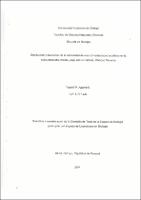Mostrar el registro sencillo del ítem
Distribución y diversidad de la comunidad de macroinvertebrados acuáticos en la sub cuenca alta , media y baja del río Caldera, Chiriquí, Panamá.
| dc.contributor.author | Aguirre, Yusseff P. | |
| dc.date.accessioned | 2023-11-15T17:31:32Z | |
| dc.date.available | 2023-11-15T17:31:32Z | |
| dc.date.issued | 2014 | |
| dc.identifier.uri | http://jadimike.unachi.ac.pa/handle/123456789/1023 | |
| dc.description.abstract | With the objective of determine the diversity and quality of water, were sampled aquatic macroinvertebrates in six stations along the subbasins high, middle and lower of Caldera river, Chiriqui, Panama, during the dry season (December 2011 April 2012). In each station was sampled twice per month in periods of 45 minutes each. In this study were used three types of sampling: a-) triangular net, b-) sampling rocks with entomological weezers and c-) litterfall collection. Samples were placed in plastic containers properly labeled, with 70 % ethanol. The total diversity for the study area was high (H '= 3.37), which was composed by 5849 individuals, identified in 115 genera belonging to 62 families, in 16 orders of the classes Oligochaeta, Insecta, Aracnoidea and Gastropoda. The greater abundance of individuals was obtained at station 2, with a value of 1278, and the orders that showed higher abundance were Diptera and Trichoptera, 1489 and 1298 individuals, respectively. The most representative families were Simuliidae and Chironomidae, while the order with the most quantity of families was Coleoptera. The Sorenson quantitative index showed that the stations with greater similarity were: 5 and 6 with a value of 69.3 %, whereas the lowest similarities were between the stations 2 and 6, with 11.3 %. According to BMWP/Pan, the water quality of Caldera river, during this season was good to excellent. This study showed the applicability of using aquatic macroinvertebrates to determine damage to fluvial ecosystems. | es_ES |
| dc.description.abstract | Con el objetivo de determinar la diversidad y calidad del agua se realizaron muestreos de macroinvertebrados acuáticos en seis estaciones a lo largo de las subcuencas alta, media y baja del rio Caldera, Chiriquí, Panamá, durante la época seca (diciembre de 2011 - abril de 2012). Cada estación fue muestreada dos veces por mes durante perfodos de 45 minutos cada una.Se utilizaron tres tipos de muestreos los cuales fueron: a-) la red triangular, b-) muestreo en rocas con pinzas entomológicas, y c-) recolecta de hojarasca. Las muestras fueron colocadas en envases plásticos debidamente rotulados, y con alcohol al 70 %. La diversidad total para el área de estudio fue alta (H'= 3.36), la cual estuvo compuesta por 5849 individuos, identificadas en 115 géneros pertenecientes a 62 familias, en 16 órdenes de las clases Oligochaeta, Insecta, Aracnoidea y Gastropoda. La mayor abundancia de individuos se obtuvo en la estación 2 con un valor de 1278 individuos, y los órdenes que presentaron mayor abundancia fueron Díptera y Trichoptera, con 1489 y 1298 individuos, respectivamente. Las familias más representativas fueron Simuliidae y Chironomidae, mientras que el orden con mayor cantidad de familias fue Coleoptera. El indice de Sorenson cuantitativo mostró que las estaciones con mayor similitud fueron la 5 y la 6 con un valor de 69.3 %, en tanto que las de menor similitud fueron la 2 y 6 con 11.3 %. Según el BMWP/Pan, la calidad del agua del río Caldera durante esta época fue de buena a excelente. Este estudio mostró la aplicabilidad del uso de macroinvertebrados acuáticos, para determinar daños en los ecosistemas fluviales. | |
| dc.language.iso | es | es_ES |
| dc.publisher | Universidad Autónoma de Chiriquí | es_ES |
| dc.subject | ECOSISTEMA ACUÁTICO | es_ES |
| dc.subject | RIO CALDERA | es_ES |
| dc.subject | TESIS - BIOLOGÍA | es_ES |
| dc.title | Distribución y diversidad de la comunidad de macroinvertebrados acuáticos en la sub cuenca alta , media y baja del río Caldera, Chiriquí, Panamá. | es_ES |
| dc.type | Thesis | es_ES |
Ficheros en el ítem
Este ítem aparece en la(s) siguiente(s) colección(ones)
-
Licenciatura en Biología.
Tesis de la escuela de Biología.

